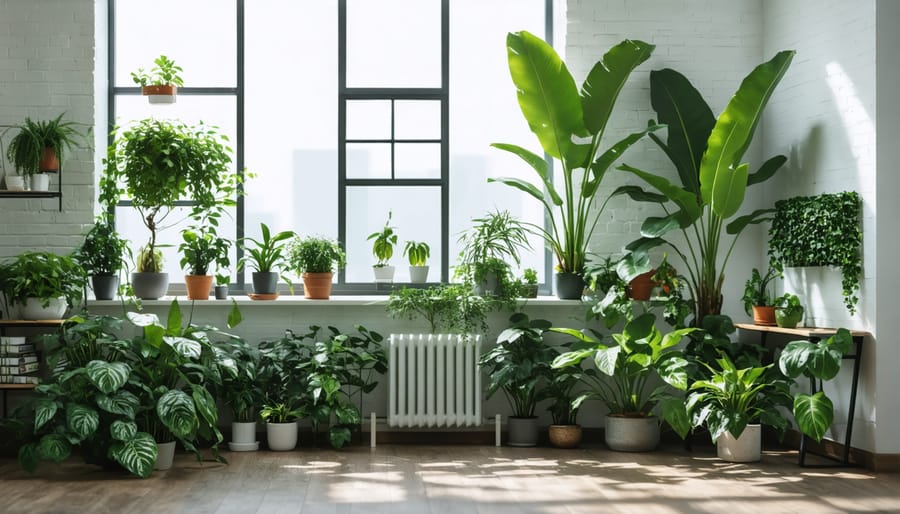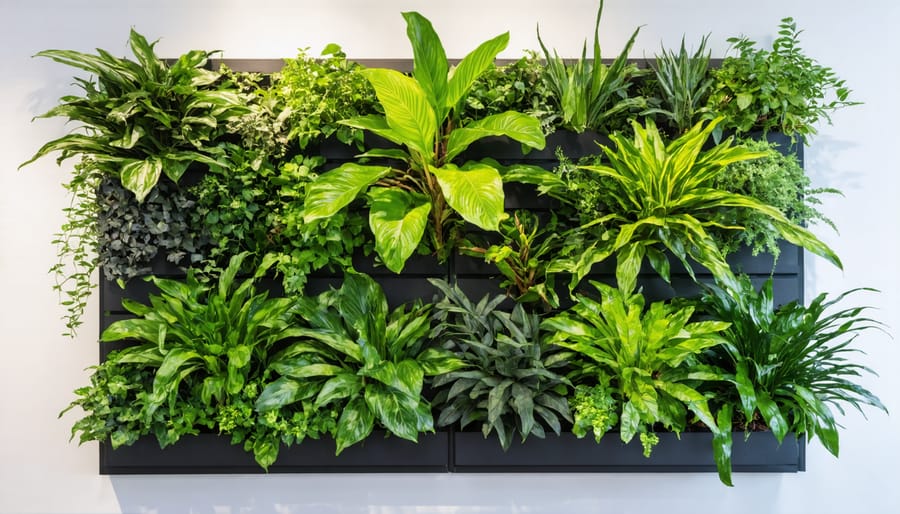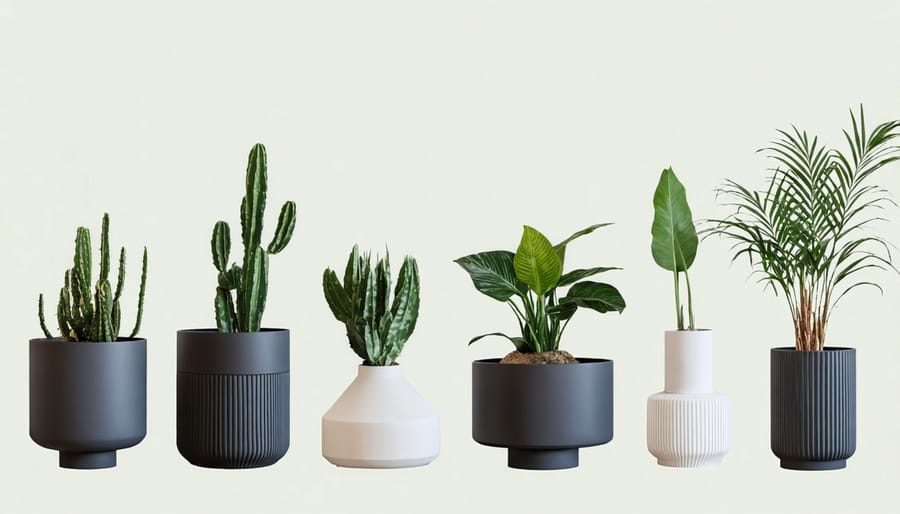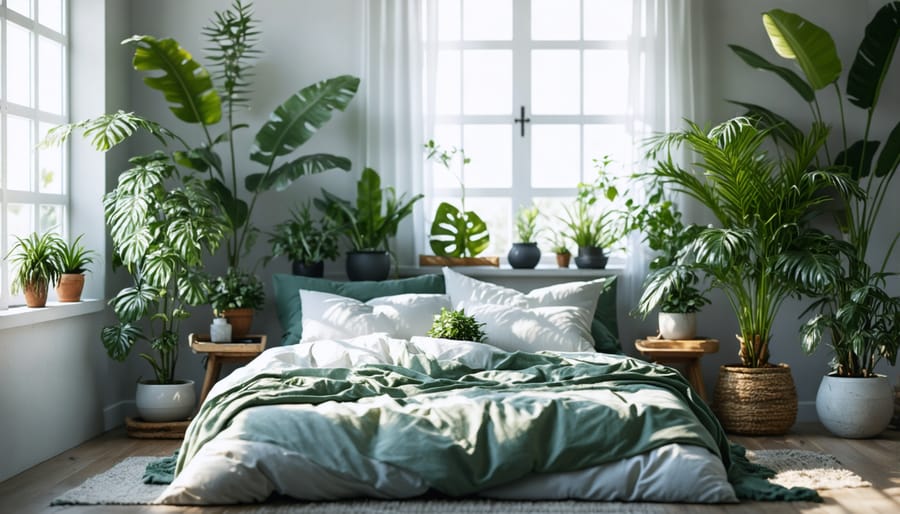Transform your living spaces into vibrant, living sanctuaries by strategically incorporating houseplants following biophilic design principles. Create stunning plant displays by grouping varieties with similar care needs in odd numbers, varying their heights and textures for visual impact. Position larger statement plants like Fiddle Leaf Figs or Bird of Paradise in room corners to anchor your design, while arranging smaller plants on floating shelves, windowsills, and coffee tables to establish rhythm and flow. Layer your greenery across different elevations—floor, table, and hanging planters—to draw the eye upward and maximize vertical space while maintaining a cohesive look. Select containers that complement your existing décor, using a mix of materials like ceramic, brass, and natural fibers to add depth and interest to your plant arrangements. This thoughtful approach to decorating with houseplants not only enhances your home’s aesthetic but also creates a nurturing environment that seamlessly blends nature with modern living.
Choosing the Right Plants for Different Spaces
Light-Level Assessment
Before choosing your houseplants, it’s essential to understand the lighting conditions in your space. Start by observing how sunlight moves through your rooms throughout the day. South-facing windows typically provide bright, direct light perfect for sun-loving plants like succulents and cacti. East and west windows offer moderate light suitable for many tropical plants, while north-facing windows provide gentle, indirect light ideal for shade-tolerant species.
To test light levels, try the shadow test: Hold your hand about 12 inches from a wall or floor during peak daylight hours. A sharp, dark shadow indicates bright light; a fuzzy, less defined shadow suggests medium light; and barely visible or no shadow means low light conditions.
Consider seasonal changes too – summer sun differs significantly from winter light. Also, account for outdoor obstacles like trees or buildings that might block sunlight. For spaces with limited natural light, you might need to supplement with grow lights or stick to low-light champions like snake plants and ZZ plants.
Remember, most plant labels indicate light requirements, so match these to your room’s conditions for thriving, healthy plants.

Space-Smart Selection
Making the most of your available space is crucial when decorating with houseplants. Start by assessing your room’s dimensions, paying special attention to vertical space that’s often overlooked. For compact areas, consider wall-mounted planters or hanging baskets that draw the eye upward without consuming precious floor space.
Choose plants that match your spatial constraints. For small spaces, opt for compact varieties like pothos, snake plants, or peace lilies that won’t overwhelm the room. If you’re blessed with high ceilings, take advantage of trailing plants like string of pearls or English ivy that can create dramatic cascading effects.
Consider growth patterns when selecting your plants. Some species, like monstera or fiddle leaf fig, can grow quite large and may need significant space to spread out. For tight corners or narrow spaces, look for plants with upright growth habits, such as ZZ plants or bamboo palms.
Window sills and shelving units offer excellent opportunities for smaller plants. Create depth by varying plant heights and sizes, placing larger plants at the back and smaller ones in front. For areas with limited natural light, choose low-light tolerant species that can thrive away from windows.
Don’t forget about the power of miniature plants. Succulents, air plants, and small ferns can transform even the tiniest spaces into green sanctuaries. These compact beauties work well on desks, coffee tables, or bathroom counters where space is limited.
Remember to factor in future growth when positioning your plants. What fits perfectly today might need more room in six months, so leave some space for your green friends to mature and flourish.
Creative Display Methods
Vertical Gardens
Vertical gardens are a game-changer for plant lovers working with limited floor space. These eye-catching living wall installations can transform any blank wall into a lush, green masterpiece. Start small with modular pocket planters, which allow you to create custom arrangements that can grow with your confidence. These fabric or plastic pouches attach securely to walls and are perfect for housing small trailing plants and herbs.
For a more structured look, consider installing a grid-system with mounted planters. These systems typically use lightweight containers that clip into a wall-mounted frame, making it easy to rearrange plants or remove them for maintenance. Plant stands with multiple tiers offer a freestanding alternative that creates vertical interest without permanent installation.
Hanging displays are another versatile option. Try clustering macramé plant hangers at varying heights to create visual depth, or install floating shelves for a clean, modern aesthetic. For rental-friendly solutions, tension rods between walls can support multiple hanging planters without leaving damage.
When designing your vertical garden, consider plant varieties that naturally grow upward or cascade downward. Pothos, philodendrons, and string-of-pearls are excellent choices that thrive in vertical settings while creating stunning visual effects. Remember to install proper drainage solutions and consider water-resistant backing to protect your walls from moisture damage.

Plant Grouping Techniques
When it comes to creating eye-catching plant displays, mastering the art of grouping can help you style indoor plants effortlessly. Start by following the classic “thriller, filler, spiller” approach: combine tall, statement plants with medium-sized leafy varieties and trailing plants that cascade over edges.
Create visual interest by varying plant heights, with taller plants at the back and shorter ones in front. Group plants in odd numbers (three, five, or seven) as this naturally appeals to the eye. Mix different leaf shapes and textures – pair large-leafed plants like monstera with feathery ferns or spiky snake plants for contrast.
Consider creating mini ecosystems by grouping plants with similar care needs together. This not only looks cohesive but also makes maintenance easier. For example, cluster humidity-loving plants like calathea and ferns in your bathroom, where they can thrive together.
Play with different pot heights and materials to add dimension to your groupings. Try placing plants on stands, books, or boxes to create varying levels. Keep your arrangement cohesive by choosing planters that share a common element – whether it’s color, material, or style.
Remember to leave enough space between plants for proper air circulation and growth. As your plants mature, don’t be afraid to adjust your groupings to accommodate their changing sizes and shapes.
Unexpected Plant Spots
Think beyond the traditional windowsill! Your home is filled with unexpected spots perfect for adding a touch of green. Transform your bathroom into a tropical oasis by hanging trailing pothos or ferns from shower curtain rods – they’ll thrive in the humid environment. Consider mounting air plants on bathroom mirrors or arranging small succulents along the edge of your tub.
Kitchen spaces offer creative opportunities too. Install small herb planters under cabinet lighting, or create a living wall of plants on magnetic strips attached to your refrigerator. Don’t forget the tops of kitchen cabinets – larger plants with trailing vines can create a stunning overhead display.
Make use of vertical space by turning old ladders into plant stands, hanging macramé planters from curtain rods, or installing floating shelves in narrow corners. Unused chairs can become plant pedestals, while old teacups and vintage containers make charming homes for small succulents.
Look up – ceiling beams and exposed pipes (when safely accessible) can support hanging plants. Transform your workspace by placing small plants in pencil holders or using them as natural bookends on shelves. Even your bedroom can benefit from unexpected greenery – try mounting wall planters above your headboard or placing cascade plants on top of tall wardrobes.
Remember, any spot with appropriate light conditions can become a plant paradise with a bit of creativity.
Stylish Plant Container Ideas

Container Selection
Selecting the right containers for your houseplants is just as important as choosing the plants themselves. Think of pots as the jewelry that complements your green companions while tying them into your overall décor scheme. When browsing for creative indoor planters, consider both aesthetics and functionality.
Start by choosing materials that match your interior style. Ceramic and terracotta pots work beautifully in traditional or Mediterranean-inspired spaces, while sleek metallic or concrete containers suit modern aesthetics. For a cohesive look, select stylish plant containers that echo colors or patterns already present in your room.
Remember to factor in size proportions – your pot should be about one-third the height of your plant for visual balance. For a designer touch, try grouping containers in odd numbers, varying their heights and textures while maintaining a common element like color or material.
Don’t forget practical considerations: ensure all containers have drainage holes, or use cache pots with proper drainage solutions. For larger plants, consider lightweight materials like composite or fiberglass, especially if you plan to move them occasionally. Mix and match containers while maintaining a unified theme to create visual interest without chaos.
DIY Container Projects
Transform ordinary plant containers into stunning decorative pieces with these creative DIY projects. Start by giving plain terracotta pots a fresh look with chalk paint, creating a modern matte finish that complements any décor style. For a bohemian touch, wrap rope or macramé cord around smooth containers, securing it with hot glue as you go.
Make a statement with color-blocked pots by using painter’s tape to create clean lines and painting sections in coordinating colors. Try metallic accents by adding gold leaf to pot rims or creating geometric patterns with copper paint. For a vintage look, experiment with decoupage using botanical prints or old maps.
Upcycle everyday items into unique planters – transform wooden crates into hanging gardens, repurpose teacups for succulents, or convert wine bottles into self-watering containers. Add personality with hand-painted designs, like simple dots, stripes, or botanical motifs. For texture, try creating a concrete effect using textured spray paint or adding dimensional elements with air-dry clay.
Remember to seal painted containers with weather-resistant clear coat for durability, especially for outdoor use. Always ensure proper drainage by drilling holes in the bottom of repurposed containers. Consider grouping containers in odd numbers and varying heights for visual interest, using your customized pieces as focal points in your plant displays.
Styling Different Rooms
Living Room Arrangements
Your living room is the heart of your home, making it the perfect canvas for creating stunning plant displays. Start by identifying natural focal points – think window areas, empty corners, or that space above your fireplace mantel. These spots are prime real estate for statement plants like a majestic Fiddle Leaf Fig or an elegant Bird of Paradise.
Consider the rule of three when arranging plants: group them in varying heights to create visual interest. Place taller plants like a Snake Plant or Monstera in the background, medium-sized plants like Pothos in the middle, and smaller specimens like succulents in the foreground. This layered approach adds depth and dimension to your space.
Empty corners can be transformed into lush plant nooks with a combination of floor plants and hanging varieties. Try positioning a tall floor plant like a Rubber Tree, then supplement with hanging plants at different heights to create a cascading effect. Coffee tables and side tables offer perfect spots for smaller plant groupings – just ensure they don’t obstruct conversation or movement.
Balance is key in living room arrangements. If you have a large plant on one side of the room, echo that with either another substantial plant or a grouping of smaller ones on the opposite side. Use plant stands and decorative pots of varying heights to create rhythm and flow throughout the space.
Remember to consider your room’s lighting conditions when selecting and positioning plants. Place sun-loving varieties near windows and more tolerant species in darker corners. This thoughtful arrangement ensures both your plants and your living room design will thrive.
Bedroom Botanicals
Transform your bedroom into a tranquil oasis by strategically incorporating calming houseplants. Snake plants and peace lilies are excellent choices for bedrooms, as they naturally purify the air and release oxygen at night. Place these plants away from your bed, preferably near windows where they can thrive without overwhelming the space.
Consider creating a gentle focal point with a cascading pothos or string of pearls on a floating shelf above your headboard. These trailing plants add a soft, natural element without taking up valuable floor space. For smaller bedrooms, utilize vertical space with wall-mounted planters or macramé hangers filled with low-maintenance plants like heart-leaf philodendrons.
Opt for calming colors in your plant selection – think soft greens and subtle variegation rather than bold, energetic varieties. A small collection of succulents on your bedside table can create a serene vignette without requiring much maintenance. If your bedroom has low light, Chinese evergreens and ZZ plants will thrive while maintaining the peaceful atmosphere.
Remember to keep the arrangement simple and uncluttered. Two or three statement plants paired with a few smaller specimens usually create the perfect balance. Position taller plants like bamboo palms in corners to frame the space naturally, and consider using ceramic pots in neutral tones to maintain the room’s restful ambiance.

Kitchen and Bathroom Greenery
Your kitchen and bathroom might not be the first places you think of for houseplants, but these humid environments actually create perfect conditions for certain plant varieties. The natural moisture from showers, baths, and cooking creates a mini tropical environment that many plants absolutely love.
In the bathroom, consider adding peace lilies, which thrive in low-light conditions and love humidity. Boston ferns make excellent shower companions, as their drooping fronds create a spa-like atmosphere while benefiting from the steam. Snake plants are another excellent choice, as they’re nearly indestructible and help purify the air.
For your kitchen, herbs are both practical and decorative. Place a small herb garden on your windowsill, including basil, mint, and oregano. Not only will they add fresh greenery, but they’ll also be readily available when cooking. Chinese evergreens and pothos plants work well on kitchen counters or shelves, as they’re adaptable to various light conditions and don’t mind occasional cooking humidity.
When placing plants in these spaces, remember these key tips:
– Use well-draining pots to prevent water accumulation
– Ensure adequate airflow to prevent mold growth
– Choose containers that complement your fixtures and tiles
– Consider hanging planters to save counter space
– Keep plants away from direct water splashes
For bathrooms without windows, opt for low-light specialists like ZZ plants or cast iron plants. In kitchens, keep plants away from heat sources and cooking zones. With the right selection and placement, your kitchen and bathroom can become lush, vibrant spaces that feel more connected to nature.
Decorating with houseplants is more than just a design trend – it’s a wonderful way to bring life, color, and natural beauty into your living spaces. As we’ve explored throughout this guide, there are countless creative ways to incorporate plants into your home décor, from striking floor plants that make bold statements to delicate hanging arrangements that add vertical interest.
Remember that successful plant decoration is about finding the right balance between your space, your lifestyle, and your green companions. Start small with a few easy-care plants in key locations, then gradually expand your indoor garden as your confidence grows. Don’t be afraid to experiment with different heights, textures, and containers to create visual interest and personality in each room.
The benefits of decorating with houseplants extend far beyond aesthetics. These green additions can improve air quality, boost mood, and create a more peaceful and welcoming environment. Whether you’re a seasoned plant parent or just beginning your journey, there’s always room to grow and evolve your plant décor style.
Take the principles we’ve discussed – considering light conditions, choosing appropriate containers, grouping plants effectively, and maintaining proper care – and make them your own. Your plant-decorated space should reflect your personal style while creating a harmonious environment that both you and your plants can thrive in.
Ready to start your plant decoration journey? Pick up a few plants this weekend and watch as they transform your space into a more vibrant, living sanctuary.
